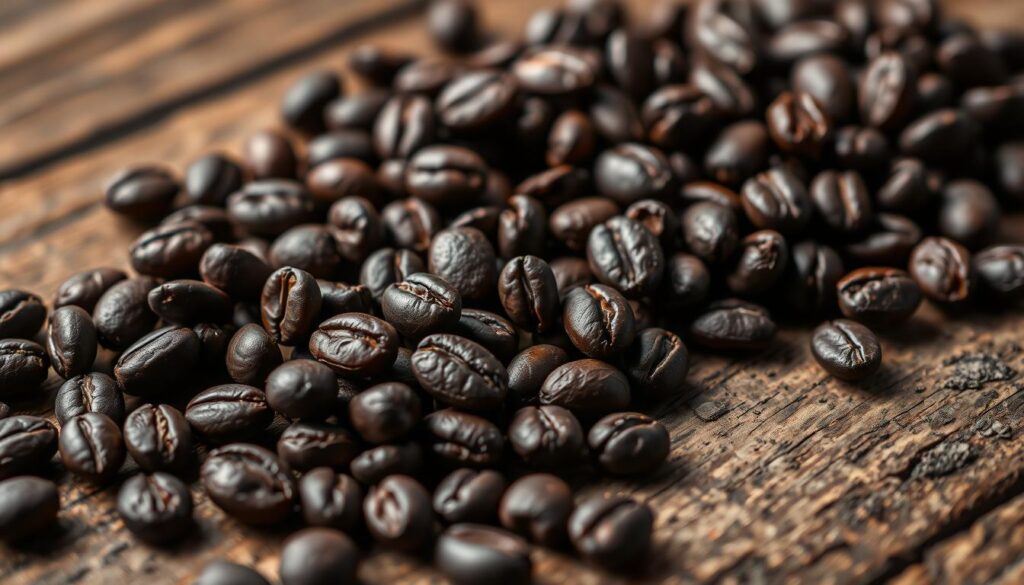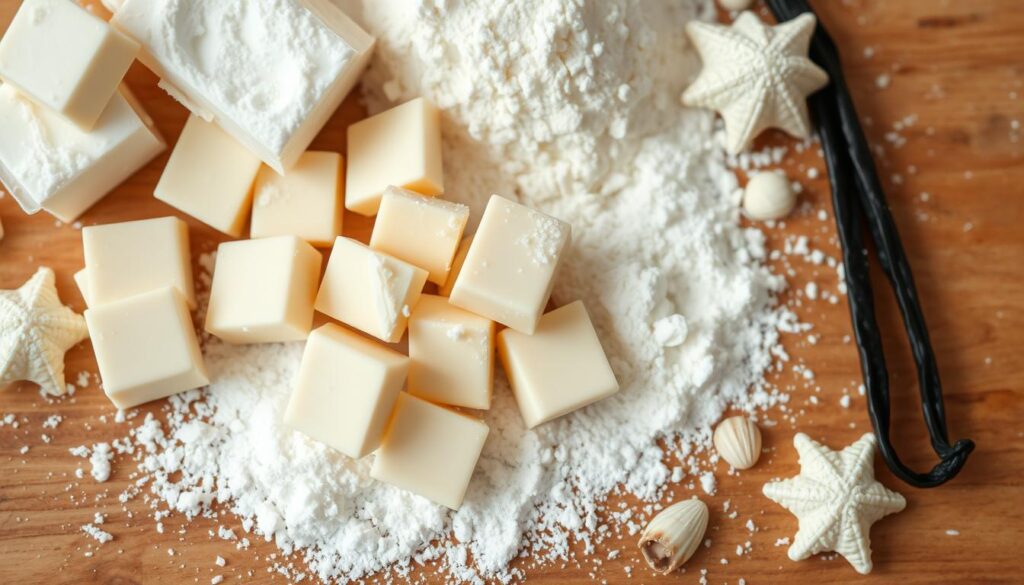As I unwrap the smooth, creamy bar, the scent of vanilla beans and cocoa butter fills the air. It takes me to a world of pure indulgence. White chocolate, with its milky flavor and ivory color, is a symbol of luxury in the world of sweets. This guide will explore its history, what it’s made of, and how it’s used in cooking.
Table of Contents
Key Takeaways
- White chocolate is a unique confection made from the cocoa bean. It has a creamy texture and a milky flavor.
- The history of white chocolate goes back to the early 20th century. It started in Switzerland as a way to use up powdered milk.
- White chocolate is known for its main ingredient, cocoa butter. This gives it a special taste and look compared to dark and milk chocolate.
- Craft chocolate makers are making new and exciting white chocolate flavors. They create unique and artisanal products.
- While white chocolate doesn’t have the antioxidants of dark chocolate, it has its own nutritional benefits. It gets these from milk solids.
The History of White Chocolate
Origins and Significance
White chocolate first appeared in the early 20th century. It was a new creation, showing the creativity of chocolate makers. They wanted to make chocolate even better.
Switzerland played a big role in making white chocolate. In the 1930s, Swiss chocolatiers made it to use extra cocoa butter. This made white chocolate special because it lets people try new flavors.

White chocolate’s popularity has changed over time. But lately, it’s become more popular again. Pastry chefs and dessert makers are using it in new and exciting ways.
Today, white chocolate is a big part of the chocolate world. It’s found in bars, truffles, and spreads. It’s a favorite for those who love luxury and delicious treats.
What is White Chocolate?
White chocolate is a special type of chocolate made from cocoa butter. It has a creamy texture and a sweet taste with a hint of caramel. Unlike other chocolates, it doesn’t have cocoa solids, making it pure and smooth.
White chocolate is made with cocoa butter, sugar, and milk solids. This mix gives it a velvety feel and a sweet taste. It’s a favorite for those who love creamy and sweet treats.
White chocolate is popular, making up 10% of the chocolate market in 2022. It’s expected to grow by 5% in 2024 and beyond. This growth is mainly due to the increasing demand for premium white chocolate, especially in Europe.
In the European Union, white chocolate must have at least 20% cocoa butter. It also needs 14% total milk solids with enough milk fat to make up 3.5%. The United States has similar rules, requiring at least 20% cacao fat, 3.5% milkfat, and 14% total milk solids.
| Ingredient | Contribution |
|---|---|
| Cocoa Butter | The main fat source in white chocolate |
| Sugar | Can vary, with a standard serving containing 15 to 20 grams or more |
| Milk Solids | Contribute to the milky flavor and creamy texture of white chocolate |
| Vanilla | Used to enhance the taste and aroma of white chocolate |
| Lecithin | Used as an emulsifier in white chocolate production |
White chocolate may not have the health benefits of dark chocolate. But it’s still a favorite for its unique taste and creamy texture. It’s a versatile ingredient in many recipes, adding sweetness and richness.

The Making of White Chocolate
From Bean to Bar
To truly enjoy white chocolate, you must understand how it’s made. At its core is cocoa butter, the essence that gives it a rich feel. This butter comes from cocoa beans and is carefully deodorized to remove any strong cocoa taste. This leaves behind a smooth, luxurious base.
This refined cocoa butter is mixed with sugar and milk solids to make white chocolate. Sugar adds sweetness, and milk solids bring a creamy depth. This mix ensures each bite is a delight for the senses. High-quality white chocolate has an off-white or cream color, showing the natural yellow of the cocoa butter.
| Ingredient | Percentage |
|---|---|
| Cocoa Butter | No less than 20% |
| Milk Solids | No less than 14% |
| Milkfat | No less than 3.5% |
| Sugar | No more than 55% |
The careful mix of these top-notch ingredients makes high-quality white chocolate special. It’s a treat that excites the senses and pleases the taste buds.
“Cocoa butter, the soul of white chocolate, is the source of its luscious texture.”
Varieties of White Chocolate
The world of chocolate is always changing, and so is white chocolate. There are classic favorites and new, exciting flavors to try. The white chocolate bar is a timeless choice, known for its smooth texture and sweet taste. It’s perfect for those who love a simple yet indulgent treat.
White chocolate chips are great for adding a touch of luxury to your favorite recipes. They’re small but pack a big punch of creamy sweetness. They’re perfect for making your baked goods extra special.
White chocolate truffles are a treat for the senses. They’re small but filled with rich, creamy centers. Flavors like vanilla or champagne add an extra layer of delight. And for a quick and easy treat, try white chocolate spread on your toast or scone.
Craft chocolate makers are always coming up with new and exciting flavors. You can find everything from matcha bars to cinnamon toast-inspired treats. The world of white chocolate is full of possibilities.
“White chocolate is experiencing a renaissance in the culinary industry, with artisanal producers crafting rich and indulgent bars using the finest ingredients.”
Whether you love the classics or are up for trying something new, there’s a white chocolate for you. Enjoy the timeless elegance or explore the latest trends. The choice is yours.
White Chocolate vs Dark vs Milk
In the world of chocolate, white, dark, and milk each offer a unique taste. Milk chocolate is loved by 49% of Americans for its sweetness. Dark chocolate wins over 34% with its strong taste. And 17% are drawn to white chocolate’s creamy feel.
Dark chocolate has a cocoa content of 50% to 90%. It has deep, earthy flavors. Milk chocolate, with its milk, is sweeter and more familiar. White chocolate, without cocoa solids, highlights cocoa butter’s creaminess.
Flavors and Comparisons
Dark chocolate is known for its health benefits and strong taste. Milk chocolate is the favorite in the U.S. for its sweetness. White chocolate is caffeine-free and good for those with dietary restrictions.
| Chocolate Type | Cocoa Solids | Sweetness Level | Dietary Considerations |
|---|---|---|---|
| Dark Chocolate | 50-90% | Intense | High in antioxidants, often dairy-free |
| Milk Chocolate | 10-40% | Comforting | Contains milk solids, popular choice |
| White Chocolate | 0% | Creamy | Caffeine-free, dairy-free, nut-free |
The chocolate world is growing, with white chocolate getting more attention. Whether you like dark, milk, or white chocolate, there’s something for everyone. The variety of chocolate is endless and exciting.
“White chocolate’s lack of cocoa solids allows the inherent sweetness of cocoa butter to shine, offering a canvas for subtler, nuanced notes.”
White Chocolate in Culinary Delights
White chocolate is a key player in the world of cooking. It’s loved by both bakers and chefs. Its creamy texture and sweet taste are perfect for cookies, cakes, and pastries. You can make everything from white chocolate ganache to truffles.
But white chocolate isn’t just for sweets. It’s also great in savory dishes. Chefs use it in sauces, glazes, and even main courses. Its creamy nature can balance out many flavors, making it a valuable ingredient.
White chocolate bars and new flavors are becoming more popular. This shows how much people love white chocolate. Whether you bake often or like to try new things, white chocolate has lots to offer.
“The versatility of white chocolate is truly remarkable, allowing us to explore new frontiers in the culinary world.”
The love for white chocolate keeps growing. This means chefs, bakers, and food lovers have endless chances to make amazing dishes.
White Chocolate Trends
White chocolate trends are changing with the culinary world. Craft chocolate makers are leading the way with their focus on quality and new ideas. They’re mixing white chocolate with exotic spices and unexpected ingredients. This is bringing a new wave of interest and appreciation.
Now, white chocolate is being paired with passion fruit and even decorated with edible gold leaf. This shows the bold and creative side of the industry.
Innovations and Flavor Combinations
The white chocolate market is seeing a lot of creativity and new ideas. Craft chocolate makers are experimenting with white chocolate, mixing it with unique flavors. Salted caramel, matcha green tea, and even chili pepper are some of the exciting combinations they’re trying.
The rise of own-label products is also driving the demand for unique white chocolate. People are looking for avant-garde creations that show off the skill of these craft chocolate makers. They’re enjoying the range of flavors, from floral notes to rich, indulgent exotic spices.
“White chocolate is a blank canvas, allowing us to explore uncharted flavor territory and push the boundaries of what is possible,” says Sarah Jones, head chocolatier at Ethel M Chocolates.
As more people want unique and innovative white chocolate, the industry is set for more exciting changes. We can expect to see even more unexpected ingredients and avant-garde flavor combinations in the future.
White Chocolate
White chocolate shines in the world of chocolate with its creamy feel and sweet taste. It has grown from simple beginnings to a sign of luxury. For top-notch white chocolate, Ethel M Chocolates offers the best.
Ethel M uses the finest artisanal white chocolate and adds special botanical essences. Their chocolate bars and premium chocolate gifts take you on a journey of taste and luxury. It’s a chance to enjoy something beyond the usual.
| White Chocolate Stats | Key Facts |
|---|---|
| Origins | White chocolate was first sold by Swiss company Nestlé in 1936. It became available in the US in 1984. |
| Composition | White chocolate is made from cocoa butter, sugar, and milk solids. It doesn’t have cocoa solids. |
| Regulations | The EU says white chocolate must have 20% cocoa butter and 14% milk solids. The US has similar rules. |
| Market Share | In 2022, white chocolate made up 10% of the market. It’s expected to grow by about 5% by 2024. |
The white chocolate world is getting more exciting, thanks to makers like Ethel M. They add unique spices and botanical essences to their creations. This is changing what white chocolate can be.
“White chocolate shines as a top choice in the chocolate world. It’s special because it doesn’t have cocoa solids, making it a treat like no other.”
If you want a special treat or a gift for someone who loves chocolate, Ethel M Chocolates is the place to go. They will make your taste buds happy and teach you to love white chocolate even more.
The Nutritional Profile of White Chocolate
White chocolate is often seen as a rich treat. But, it’s key to know what’s in it. A typical serving has about 150-170 calories. It has 8-10 grams of fat, mostly from cocoa butter, and 15-18 grams of sugar.
White chocolate gives energy and some important nutrients. But, it has a lot of sugar and fat. So, it’s good to eat it in small amounts. It also has antioxidants from cocoa butter and helps with bone health thanks to milk solids.
| Nutrient | Amount per 100g | Percentage |
|---|---|---|
| Calories | 539 kcal | – |
| Carbohydrates | 59g | 21.45% |
| Total Fat | 31g | 39.74% |
| Protein | 8g | 16% |
| Sugar | 59g | 118% |
| Sodium | 87mg | 3.78% |
Storing white chocolate right can keep it good for up to a year. You can also use leftover white chocolate in sweet dishes. Try baking, drizzling it on cakes, or making white chocolate bark.
White chocolate isn’t the healthiest choice, but it can fit into a balanced diet. Just enjoy it in small amounts and watch its calorie, fat, and sugar content.
“White chocolate is a decadent treat that should be enjoyed in moderation, but it does offer some nutritional benefits like antioxidants and bone-healthy minerals.”
Ethical Considerations
When picking white chocolate, think about how it’s made. Look for brands that use fair trade practices and sustainable sourcing of cocoa butter. This way, farmers get fair pay and work in safe places. Brands like Zotter Chocolates make all their chocolates ethically and focus on sustainability. This lets us enjoy white chocolate without feeling guilty.
The chocolate world has big problems like child labor in West Africa. Kids as young as six work in bad conditions for almost no money. There are also big environmental issues like deforestation, pesticide use, and soil erosion linked to cocoa farming.
Fair trade certification helps cocoa farmers get fair prices and fight poverty. Organic and sustainable harvesting methods are key for good land use, less pesticide, and protecting nature.
Companies need to be open about where they get their cocoa. This shows their ethical and environmental impact. By choosing the right brands, we can help make the chocolate world better. New tech like blockchain helps show that cocoa is sourced ethically.
By choosing ethical brands like Zotter Chocolates, we can enjoy white chocolate. At the same time, we help make the chocolate world fairer and more sustainable.
“Ethical sourcing and production are essential for ensuring a fair and sustainable chocolate industry. Consumers have the power to drive positive change through their purchasing decisions.”
| Metric | 2023 Value |
|---|---|
| Dry Cacao Price per Quintal (100 lbs) in Guatemala | Q1,300 – Q1,500 |
| Wet Cacao Price per Pound in Guatemala | 4Q |
| Cacao Source Direct Farm Sourcing Price per Quintal | Q2,200 |
| Cacao Source Price per Pound for Dried Beans | 5Q – 8Q |
| Cacao Source Price per Quintal for Cacao from Collectives | Q2,500 – Q3,500 |
| Cacao Source Allocation to Indigenous Communities | 58.48% |
| Cacao Source Allocation to Ladinos (Non-Indigenous Guatemalans) | 12.21% |
| Cacao Source Allocation to International Contributors | 10.98% |
Conclusion
White chocolate is a delightful treat with a unique flavor and texture. It has a creamy, sweet taste that chocolate lovers adore. From its simple beginnings to its current popularity, white chocolate has become a symbol of luxury and creativity in cooking.
If you love white chocolate or want to try it, this guide has lots of useful information. It shows how versatile white chocolate is in desserts, drinks, and sweets. Both professional chefs and home cooks enjoy using it.
Let white chocolate add joy to your cooking. Enjoy its smooth, velvety texture and sweet taste. Explore new ways to use it in your recipes. White chocolate will always be a favorite among chocolate lovers, offering endless inspiration.
F.A.Q
What is the history of white chocolate?
White chocolate started in the early 20th century, in Switzerland in the 1930s. It was made to use up powdered milk after World War I. It lets people explore flavors without the usual chocolate limits.
How is white chocolate made?
Making white chocolate is a careful process. Cocoa butter is taken from the cocoa bean and cleaned to remove strong flavors. Then, it’s mixed with sugar and milk solids to create its creamy texture and sweetness.
What are the different varieties of white chocolate?
There are many types of white chocolate, like bars, chips, truffles, and spreads. Each type shows how versatile white chocolate can be, pleasing chocolate lovers.
How does white chocolate compare to dark and milk chocolate?
White chocolate is sweet because it doesn’t have cocoa solids. Dark chocolate is intense, and milk chocolate is sweet and nostalgic. White chocolate is a mix of buttery sweetness and creaminess.
How can white chocolate be used in culinary creations?
White chocolate is great in many recipes, like cookies, cakes, and pastries. It’s creamy and sweet, making it perfect for both sweet and savory dishes. This shows how versatile it is in cooking.
What is the nutritional profile of white chocolate?
White chocolate gives energy and some nutrients but has a lot of sugar and fat. It’s best to eat it in small amounts as part of a healthy diet. A small piece has about 150-170 calories, 8-10 grams of fat, and 15-18 grams of sugar.
What should I consider when choosing ethical white chocolate?
When picking white chocolate, think about how it’s made. Look for brands that support fair trade and sustainable cocoa butter. Brands like Zotter Chocolates focus on being ethical and sustainable, so you can enjoy white chocolate without guilt.



